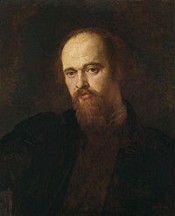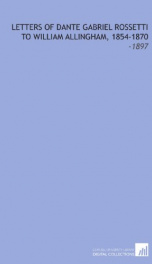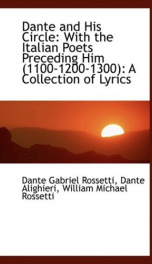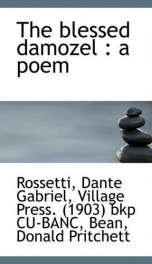Rossetti Dante Gabriel

Dante Gabriel Rossetti (12 May 1828 – 9 April 1882) was an English poet, illustrator, painter and translator. He was one of the founders of the Pre-Raphaelite Brotherhood in 1848 and was later to be the main inspiration for second generation of artists and writers influenced by the movement. He was also a major precursor of the Aesthetic movement. Rossetti's art was characterised by its sensuality and its medieval revivalism. His early poetry was influenced by Keats. His later poetry was characterised by the complex interlinking of thought and feeling, especially in his sonnet sequence The House of Life. Rossetti's personal life was closely linked to his work, especially his relationships with his models and muses Elizabeth Siddal and Jane Morris. The son of émigré Italian scholar Gabriel Pasquale Giuseppe Rossetti and his wife Frances Polidori, D.G. Rossetti was born in London, England and originally named Gabriel Charles Dante Rossetti. His family and friends called him "Gabriel", but in publications he put the name Dante first (in honour of Dante Alighieri). He was the brother of poet Christina Rossetti, the critic William Michael Rossetti, and author Maria Francesca Rossetti. Like all his siblings, he aspired to be a poet and attended King's College School. However, he also wished to be a painter, having shown a great interest in Medieval Italian art. He studied at Henry Sass's Drawing Academy from 1841 to 1845 when he enrolled at the Antique School of the Royal Academy, leaving in 1848. After leaving the Royal Academy, Rossetti studied under Ford Madox Brown, with whom he was to retain a close relationship throughout his life. Following the exhibition of William Holman Hunt's painting The Eve of St. Agnes, Rossetti sought out Hunt's friendship. The painting illustrated a poem by the then still little-known John Keats. Rossetti's own poem "The Blessed Damozel" was an imitation of Keats, so he believed that Hunt might share his artistic and literary ideals. Together they developed the philosophy of the Pre-Raphaelite Brotherhood, which they founded along with John Everett Millais. Rossetti was always more interested in the Medieval than in the modern side of the movement. He was publishing translations of Dante and other Medieval Italian poets, and his art also sought to adopt the stylistic characteristics of the early Italians. In 1850, Rossetti met Elizabeth Siddal, who became an important model for the Pre-Raphaelite painters. They were married in 1860. Rossetti's first major paintings display some of the realist qualities of the early Pre-Raphaelite movement. His Girlhood of Mary, Virgin and Ecce Ancilla Domini both portray Mary as an emaciated and repressed teenage girl. His incomplete picture Found was his only major modern-life subject. It depicted a prostitute, lifted up from the street by a country-drover who recognises his old sweetheart. However, Rossetti increasingly preferred symbolic and mythological images to realistic ones. This was also true of his later poetry. Many of the ladies he portrayed have the image of idealized Botticelli's Venus, who was supposed to portray Simonetta Vespucci. Although he won support from John Ruskin, criticism of his paintings caused Rossetti to withdraw from public exhibitions and turn to watercolours, which could be sold privately. In 1861, Rossetti published The Early Italian Poets, a set of English translations of Italian poetry including Dante Alighieri's La Vita Nuova. These, and Sir Thomas Malory's Morte d'Arthur, inspired his art in the 1850s. His visions of Arthurian romance and medieval design also inspired his new friends of this time, William Morris and Edward Burne-Jones. Rossetti also typically wrote sonnets for his pictures, such as "Astarte Syriaca". As a designer, he worked with William Morris to produce images for stained glass and other decorative devices. Both these developments were precipitated by events in his private life, in particular by the death of his wife Elizabeth Siddal. She had taken an overdose of laudanum shortly after giving birth to a stillborn child. Rossetti became increasingly depressed, and buried the bulk of his unpublished poems in his wife's grave at Highgate Cemetery, though he would later have them exhumed. He idealised her image as Dante's Beatrice in a number of paintings, such as Beata Beatrix. These paintings were to be a major influence on the development of the European Symbolist movement. In these works, Rossetti's depiction of women became almost obsessively stylised. He tended to portray his new lover Fanny Cornforth as the epitome of physical eroticism, whilst another of his alleged mistresses Jane Burden, the wife of his business partner William Morris, was glamorised as an ethereal goddess. During this time, Rossetti acquired an obsession for exotic animals, and in particular wombats. He would frequently ask friends to meet him at the "Wombat's Lair" at the London Zoo in Regent's Park, and would spend hours there himself. Finally, in September 1869, he was to acquire the first of two pet wombats. This short-lived wombat, named "Top", was often brought to the dinner table and allowed to sleep in the large centrepiece of the dinner table during meals. This fascination with exotic animals continued throughout Rossettis' life, finally culminating in the purchase of a llama and a Toucan which Rossetti would dress in a cowboy hat and persuade it to ride the llama round the dining table for his amusement.[1] During these years, Rossetti was prevailed upon by friends, in particular Charles Augustus Howell, to exhume his poems from his wife's grave. This he did, collating and publishing them in 1870 in the volume Poems by D. G. Rossetti. They created a controversy when they were attacked as the epitome of the "fleshly school of poetry". The eroticism and sensuality of the poems caused offence. One poem, "Nuptial Sleep", described a couple falling asleep after sex. This was part of Rossetti's sonnet sequence The House of Life, a complex series of poems tracing the physical and spiritual development of an intimate relationship. Rossetti described the sonnet form as a "moment's monument", implying that it sought to contain the feelings of a fleeting moment, and to reflect upon their meaning. The House of Life was a series of interacting monuments to these moments — an elaborate whole made from a mosaic of intensely described fragments. This was Rossetti's most substantial literary achievement. In 1881, Rossetti published a second volume of poems, Ballads and Sonnets, which included the remaining sonnets from the The House of Life sequence. Toward the end of his life, Rossetti sank into a morbid state, darkened by his drug addiction to chloral and increasing mental instability, possibly worsened by his reaction to the savage critical attacks on his disinterred (1869) poetry from the manuscript poems he had buried with his wife. He spent his last years as a recluse. On Easter Sunday, 1882, he died at the country house of a friend, where he had gone in yet another vain attempt to recover his health, which had been destroyed by chloral as his wife's had been destroyed by laudanum. He is buried at Birchington-on-Sea, Kent, England. His grave is visited regularly by admirers of his life's work and achievements and this can be seen by fresh flowers placed there regularly. Birmingham, Manchester and Salford Museum and Art Galleries all contain large collections of Rossetti's work; the latter was bequeathed a number of works following the death of L.S. Lowry in 1976. Lowry was president of the Newcastle-based 'Rossetti Society', which was founded in 1966.[2] Lowry's private collection of works was chiefly built around Rossetti's paintings and sketches of Lizzie Siddal and Jane Morris, and notable pieces included Pandora, Prosperpine and a drawing of Annie Miller. In an interview with Mervyn Levy, Lowry explained his fascination with the Rossetti women in relation to his own work: "I don't like his women at all, but they fascinate me, like a snake.That's why I always buy Rossetti whenever I can. His women are really rather horrible. It's like a friend of mine who says he hates my work, although it fascinates him."[3] The friend Lowry referred to was businessman Monty Bloom, to whom he also explained his obsession with Rossetti's portraits: "They are not real women [...] They are dreams [...] He used them for something in his mind caused by the death of his wife. I may be quite wrong there, but significantly they all came after the death of his wife."[4] Rossetti was played by Oliver Reed in Ken Russell's film Dante's Inferno (1967). The PRB as a whole have been the subjects of two BBC period dramas. The first, entitled The Love School, was shown in 1975, starring Ben Kingsley as Rossetti. The second was Desperate Romantics, in which Rossetti is played by Aidan Turner. It was first broadcast on BBC 2 Tuesday, 21 July 2009.[5]
do you like this author?
What readers are saying
What do you think? Write your own comment on this book!
write a commentWhat readers are saying
What do you think? Write your own comment on this author!
write a commentBook list

the early italian poets from ciullo dalcamo to dante alighieri 1100 1200 1300
Series:
Unknown
Year:
Unknown
Raiting:
4/5
Show more
add to favoritesadd In favorites

the blessed damozel a book of lyrics chosen from the works of dante gabriel ros
Series:
Unknown
Year:
Unknown
Raiting:
4/5
Show more
add to favoritesadd In favorites
Book list

the early italian poets from ciullo dalcamo to dante alighieri 1100 1200 1300
Series:
Unknown
Year:
Unknown
Raiting:
4/5
Show more
add to favoritesadd In favorites

the blessed damozel a book of lyrics chosen from the works of dante gabriel ros
Series:
Unknown
Year:
Unknown
Raiting:
4/5
Show more
add to favoritesadd In favorites

the blessed damozel by dante gabriel rossetti
Series:
Unknown
Year:
Unknown
Raiting:
3.5/5
Show more
add to favoritesadd In favorites

poems translations 1850 1870 together with the prose story hand and soul
Series:
Unknown
Year:
Unknown
Raiting:
3.5/5
Show more
add to favoritesadd In favorites

letters of dante gabriel rossetti to william allingham 1854 1870
Series:
Unknown
Year:
Unknown
Raiting:
3.5/5
Originally published in 1897. This volume from the Cornell University Library's print collections was scanned on an APT BookScan and converted to JPG 2000 format by Kirtas Technologies. All titles scanned cover to cover and pages may include marks notations and other marginalia present in the original volume.
Show more
add to favoritesadd In favorites

dante and his circle with the italian poets preceding him 1100 1200 1300 a
Series:
Unknown
Year:
Unknown
Raiting:
3/5
Show more
add to favoritesadd In favorites
What readers are saying
What do you think? Write your own comment on this author!
write a commentGenre
if you like Rossetti Dante Gabriel try:
readers also enjoyed
What readers are saying
What do you think? Write your own comment on this author!
write a commentGenre
if you like Rossetti Dante Gabriel try:
readers also enjoyed
Do you want to read a book that interests you? It’s EASY!
Create an account and send a request for reading to other users on the Webpage of the book!


